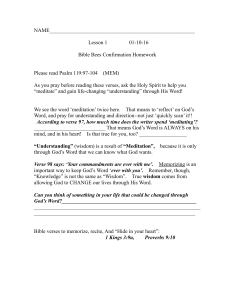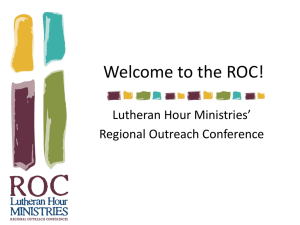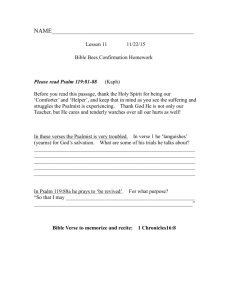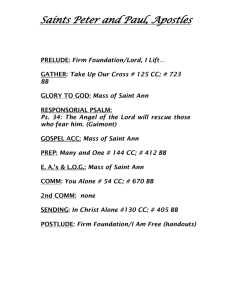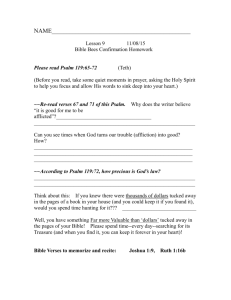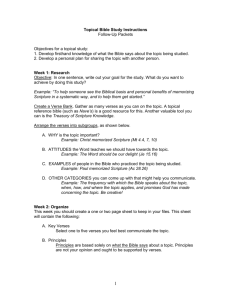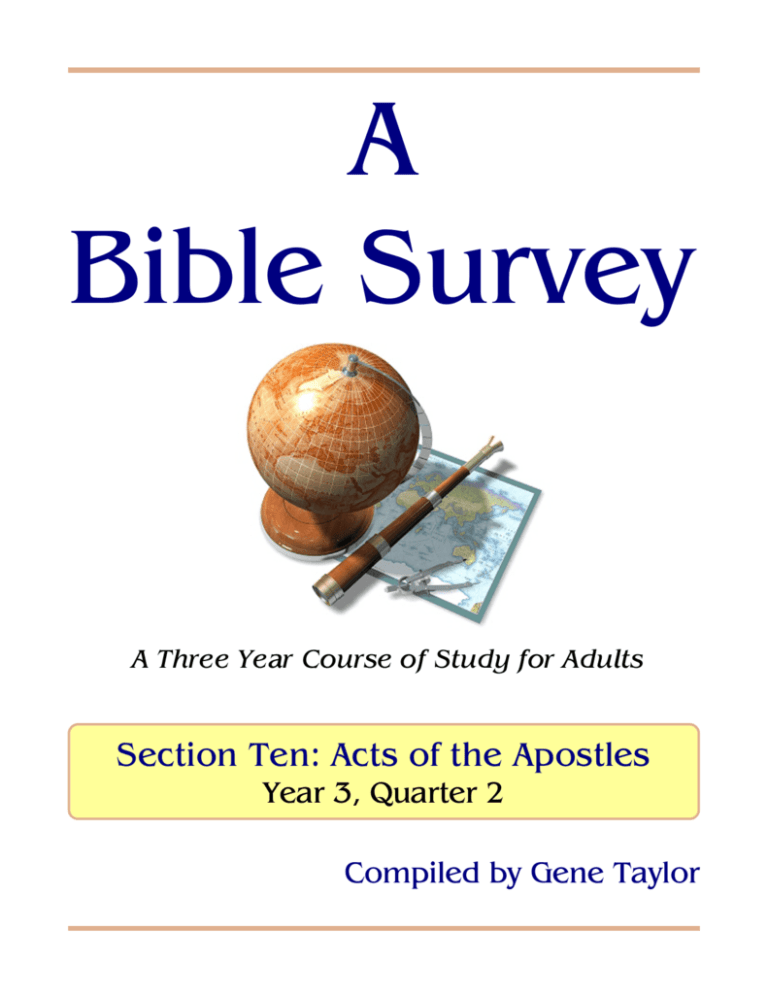
A
Bible Survey
A Three Year Course of Study for Adults
Section Ten: Acts of the Apostles
Year 3, Quarter 2
Compiled by Gene Taylor
Preface
These lessons were first compiled over a three year period from April 1988 through March 1991. The
then Westside church of Christ in Tallahassee, Florida (Now the Centerville Road church relocated to
4015 Centerville Road in Tallahassee) determined to place all their Sunday morning Bible classes on
the Amplified Bible Curriculum (Hereafter referred to as ABC) developed by JoLinda Crump and Cathy
Valdes.
While their curriculum recommended materials from preschool through senior high, we desired to place
our college, young adult, and adult classes on the same schedule. The volume of material in L.A. Mott’s
studies, recommended in the ABC for source material and lesson development, did not easily lend itself
to a once a week study since he designed his lessons to be studied twice each week.
Considering these factors, I took it upon myself to compile these lessons. We used them successfully
while cycling through the curriculum twice in our senior high, college, young adult, and adult classes
from April 1988 through March 1994. They were edited and revised prior to the second study of them.
They have been revised a second time and reformatted in 1997.
I have tried to parallel the ABC as much as possible so that adults and children would be studying the
same lesson at the same time only on different levels. But this series, or any one of its twelve study
guides, may be used independently.
Each lesson contains a schedule for daily Bible reading. It can be used as a format for family
devotionals in the home even if the whole family is not on the curriculum.
I hope you enjoy your study.
Gene Taylor
July 1997
Bible Survey Section Ten: Acts of the Apostles
Gene Taylor
-1-
Table of Contents
Preface ..................................................................................................................................................... 1
Table of Contents ..................................................................................................................................... 2
Lesson One: The Ascension ................................................................................................................... 3
Lesson Two: The Church Begins ............................................................................................................ 5
Lesson Three: Peter Imprisoned ............................................................................................................. 7
Lesson Four: Ananias and Sapphira ....................................................................................................... 9
Lesson Five: Stephen .............................................................................................................................. 11
Lesson Six: Philip .................................................................................................................................... 12
Lesson Seven: The Conversion of Saul .................................................................................................. 14
Lesson Eight: Cornelius .......................................................................................................................... 15
Lesson Nine: The First Journey of Paul .................................................................................................. 17
Lesson Ten: The Second Journey of Paul ............................................................................................... 19
Lesson Eleven: The Third Journey of Paul ............................................................................................. 22
Lesson Twelve: Paul’s Trial ................................................................................................................... 24
Lesson Thirteen: Paul’s Voyage to Rome .............................................................................................. 27
© Gene Taylor, 1997. All Rights Reserved.
Bible Survey Section Ten: Acts of the Apostles
Gene Taylor
-2-
Lesson One: The Ascension
A Charge to the Apostles (1:1-5)
Lesson Text
Acts 1:1-26
1. What former writing is connected with this book?
2. Who is Jesus addressing in verses one through eleven?
3. What were the “many infallible proofs, mentioned in verse three?
Daily Bible
Reading
4. Taking context into consideration, what is “the Promise of the Father”
in verse four?
A Question about the Kingdom (1:6-8)
Monday
Acts 1:1-14
Tuesday
Acts 1:15-22
Thursday
Acts 1:23-26
Friday
Psalm 69
Saturday
Psalm 109
Lesson
Concept
5. What likely gave rise to the question asked by Jesus’ apostles in verse
six? What do you think they meant by this question?
6. Does Matthew 21:43 have any bearing on the question asked in verse
six? Explain.
7. What is Jesus’ answer to the question posed in verse six? Why do you
think He answers as He does?
8. What would the coming of the Holy Spirit do for the apostles? Why did
Jesus want them to wait for its coming before giving their testimony?
9. What was the nature or purpose of the power referred to by Jesus?
The Ascension (1:9-11)
10. How would the ascension of Jesus aid the apostles’ understanding
in times to come?
11. Who spoke to the apostles concerning the ascension? Why?
The Upper Room (1:12-14)
GO DHEAD
Fulfilling prophecy
12. What groups of people gathered in the upper room?
13. With what were the people in the upper room occupied at this time?
Bible Survey Section Ten: Acts of the Apostles
Gene Taylor
-3-
Judas’ Replacement (1:15-26)
14. Are the Old Testament references applied to Judas in verses 15 through 20 direct prophecies of him?
How do they concern him?
15. In light of verses 21 through 26, define and discuss the nature and function of the apostolic office.
16. How many were proposed to take the place of Judas? Why only this number?
17. Who was chosen? How was the choice manifested?
Bible Survey Section Ten: Acts of the Apostles
Gene Taylor
-4-
Lesson Two: The Church Begins
The Coming of the Holy Spirit (2:1-13)
Lesson Text
Acts 2:1-47
Daily Bible
Reading
1. Of what significance was the Day of Pentecost in the Old Testament?
2. Describe the phenomena observed on the Pentecost recorded in this
chapter.
3. What is meant by “other tongues?” What was the purpose of these
“other tongues?”
4. What is there about the phenomena of Pentecost that justifies its being
described as “baptized in the Holy Spirit?”
5. What were the reactions among the people to the happenings of Pentecost?
Monday
Acts 2:1-13
Tuesday
Acts 2:14-36
Peter’s Sermon (2:14-36)
6. Since Peter’s sermon falls naturally into three main parts which are
listed below, give a heading or a brief summary for each.
Thursday
Acts 2:37-47
a. Vv. 14-21.
Friday
Joel 2:28-32
b. Vv. 22-36.
Saturday
Psalm 16
Lesson
Concept
c. Vv. 37-40.
7. What is meant by “the last days?”
8. How would you summarize Peter’s explanation of the significance of
that moment in the history of the world?
9. What is Peter’s conclusion?
The Reactions of the People (2:37-42)
10. Since Jesus had said that the Holy Spirit would “convict the world of
sin” etc. (John 16:8), considering verse 37, explain the means by which
the Spirit did His work.
CHURCH
Fulfilling prophecy
11. Considering verse 21, why the question of verse 37? Had they not
already been told? Explain.
Bible Survey Section Ten: Acts of the Apostles
Gene Taylor
-5-
12. Explain the relationship between verse 38 and verse 21. (cf. Matthew 7:21-23 and Acts 22:16)
13. Explain the meaning of the phrase “for the remission of sins” (v. 38) by using the context and the
parallel passage, Matthew 26:28. Will either of these passages allow the phrase to mean “because of
the remission of sins?”
14. What is the “gift of the Holy Spirit” that is referred to in verse 38?
15. What was done by those who received Peter’s word? What lesson(s) is to be learned here?
16. What does this passage teach about who should be baptized?
A Portrait of the Church (2:43-47)
17. Describe the life of the church in the period immediately after Pentecost.
18. Who was doing “wonders and signs” at this point?
Bible Survey Section Ten: Acts of the Apostles
Gene Taylor
-6-
Lesson Three: Peter Imprisoned
The Healing of a Lame Man (3:1-11)
Lesson Text
Acts 3:1 - 4:31
Daily Bible
Reading
1. Describe the miracle performed by Peter.
2. From the details of this account of the miracle and from what is said of it
in Acts 4:13-22, what establishes the certainty and greatness of the cure?
3. What was the reaction of the people to this healing?
Peter’s Second Sermon (3:12-26)
4. Who comprised the audience for this sermon? How was the sermon
especially adapted to the people to whom it was addressed?
5. Give an analysis of the sermon and its two main parts listed below.
Monday
Acts 3:1-16
Tuesday
Acts 3:17-26
Thursday
Acts 4:1-12
Friday
Acts 4:13-22
Saturday
Acts 4:23-31
a. Vv. 12-16.
b. Vv. 17-26.
6. List the purposes of repentance as they are stated in verses 19 and 20.
7. What is meant by the phrase “the times of restoration of all things?”
The Beginning of Persecution: Peter and Jo hn Before the Sanhedrin
(4:1-22)
8. What Jewish party (sect) was the leader of this early opposition to the
apostles? What was the reason for this opposition?
Lesson
Concept
9. How is verse four an illustration of the power of the apostolic message
even amidst adverse circumstances?
10. From details given in verses five through twelve, show how Peter takes
control of the situation using it for his own purposes.
CHURCH
Spreading the
gospel boldly
11. From verses 13 and 14, list the four facts of the case that confronted the
Sanhedrin and show the importance of each in relation to the others and
to the overall situation. To what conclusion(s) do these facts point?
12. What would have been the honorable course for the Sanhedrin to
follow? What was the Sanhedrin determined to do?
Bible Survey Section Ten: Acts of the Apostles
Gene Taylor
-7-
The Reaction of the Apostles (4:23-31)
13. What was the reaction of the other apostles when Peter and John told them what happened? What
accounted for their boldness?
14. Describe the help and inspiration the example of Peter and John provides disciples today as they
face similar situations and tasks.
Bible Survey Section Ten: Acts of the Apostles
Gene Taylor
-8-
Lesson Four: Ananias and Sapphira
A Second Portrait of the Church (4:32-37)
Lesson Text
Acts 4:32 - 5:42
Daily Bible
Reading
1. What are some features of the status of the church given in this text?
2. What can be said about the effect of persecution or opposition on the
church?
3. How was provision made for the needy among believers?
4. Who was Barnabas? What does the text record him doing? What
characteristics does this act reveal about him?
Ananias and Sapphira (5:1-11)
Monday
Acts 4:32-37
5. Compare and contrast the two attacks that Satan has made on the
church, the one in chapter four and this one in chapter five.
6. Give a full explanation of the sin of Ananias and Sapphira.
Tuesday
Acts 5:1-11
Thursday
Acts 5:12-26
Friday
Acts 5:27-32
Saturday
Acts 5:33-42
7. What was the effect of the death of Ananias and Sapphira upon the
church?
8. Does this passage illustrate any beneficial effect that can be
accomplished through church discipline? Explain.
A Third Portrait of the Church (5:12-16)
9. What seems to be the condition of the church after facing two problems?
10. How were outsiders generally viewing the church at this time?
Lesson
Concept
The Apostles Before the Sanhedrin (5:17-42)
11. What was the motivation of the rulers when they arrested the apostles?
12. With what Jewish sect was the high priest identified? How does that
help to explain what was behind the persecution?
13. How do verses 19 and 20 represent a bold challenge to the:
OBEDIENCE
a. Apostles?
W illing to face
persecution
b. Sanhedrin?
Bible Survey Section Ten: Acts of the Apostles
Gene Taylor
-9-
14. What was found by the officers the morning after the arrest of the apostles?
15. What would have been a reasonable reaction on the part of the rulers to the report of the officers?
What was their reaction? What does their reaction indicate about the character of these men?
16. Since the apostles are brought before the Sanhedrin anyway, was their release from prison useless?
Explain.
17. Discuss the importance of the principle set forth in verses 27 through 29 as furnishing a precedent to
show the responsibility of a disciple of Christ in such a situation.
18. Compare verse 33 with 2:37. How was the effect of the apostolic message similar in the two cases?
How was it different? Why the difference?
19. Who was Gamaliel? How did God use him to save the apostles? What advice did he offer?
20. Did the Jewish rulers act consistently in applying Gamaliel’s advice? What did they do?
21. How did the apostles view the beating they received?
Bible Survey Section Ten: Acts of the Apostles
Gene Taylor
-10-
Lesson Five: Stephen
Seven Chosen (6:1-7)
Lesson Text
Acts 6:1 - 7:54
Daily Bible
Reading
1. What problem arose as the church grew? Who were the “Grecian
widows?”
2. Explain the “daily ministration” in light of 2:44ff. and 4:32-35.
3. What was the apostolic solution to the church’s problem of how to care
for its needy more efficiently?
4 What is taught in verses 2 through 4 about the work of the apostles?
Were the apostles “too good” to serve tables? Explain.
5. What kind of men were to be appointed over the business of serving
tables?
Monday
Acts 6:1-15
Tuesday
Acts 7:1-19
Thursday
Acts 7:20-38
6. Did the problem of verses one through six stop the growth of the
church? Any lesson(s) here for the church today?
Charges Against Stephen (6:8-15)
7. Is Stephen the first person after Pentecost other than an apostle who is
said to have worked miracles?
8. List the stages of opposition to Stephen found in verses 8 through 14.
Friday
Acts 7:39-54
Saturday
John 16:1-6
9. List the charges against Stephen.
Stephen’s Defense (7:1-53)
10. What seems to be the two-fold object of Stephen’s speech?
Lesson
Concept
11. How do verses 17 through 43 relate to the charges against Stephen?
How do verses 44 through 50 relate to those charges?
The Death of Stephen (Acts 7:54-60)
12. How did his audience react to Stephen’s speech?
13. Compare verses 55 through 56 with Matthew 26:63-64 and Mark 14:61-62.
FAITH
Being faithful
during trials
14. In the light of John 18:31 and the necessity of bringing Jesus before Pilate
to get the death sentence, how would you explain the action of verses 57
through 59?
15. Who held the garments of those who stoned Stephen?
Bible Survey Section Ten: Acts of the Apostles
Gene Taylor
-11-
Lesson Six: Philip
The Gospel in Samaria (8:1-25)
Lesson Text
1. Describe the aftermath of the death of Stephen. How do verses one through
four show that God is ruling the world? (cf. 4:27-28; Phil. 1:12-14)
Acts 8:1-40
2. What caused the Samaritans to give heed to the preaching of Philip. What
relationship was there between his message and the signs he performed?
Daily Bible
Reading
3. Under whose influence had the Samaritans previously been and why?
4. What important precedent does verse 12 establish as to who should be
baptized?
Monday
Acts 8:1-8
Tuesday
Acts 8:9-17
Thursday
Acts 8:18-25
Friday
Acts 8:26-40
Saturday
Luke 13:1-5
Lesson
Concept
5. What was accomplished by the laying on of the apostles’ hands? What
sort of blessings of the Spirit were imparted on this occasion? What
conclusion(s) can be drawn with regard to the duration and purpose of
these special powers?
6. How can Simon be used to refute the doctrine of “once saved, always
saved?”
7. How does a person who has been baptized gain pardon from sins
committed after baptism?
Philip and the Ethiopian Eunuch (8:26-40)
8. What was the role of the angel in the conversion of the Ethiopian
eunuch?
9. What conclusions can be reached about the character of the Ethiopian
from the following?
a. His position.
b. His long trip and its purpose.
c. What he was doing as he was riding in his chariot.
CHURCH
Growing stronger
due to persecution
d. The attitude reflected in verse 31.
10. Was the Ethiopian saved before Philip came to him? Explain.
Bible Survey Section Ten: Acts of the Apostles
Gene Taylor
-12-
11. What was the Spirit’s role in the conversion of the Ethiopian? Did it agree with earlier evidence,
especially from Acts 2, concerning the manner in which the Spirit works to bring about the
conversion of sinners? Explain.
12. How would Philip’s question (v. 30) help him know how to proceed? What would the answer tell
him about this man?
13. What passage was the Ethiopian reading? Is that a good place to begin preaching Jesus? Explain.
14. What are some things that must be taught when one preaches Jesus?
15. What did early preachers say about baptism when they preached Jesus? (cf. Acts 2:38)
16. What circumstantial evidence in this text contributes toward understanding how baptism was
performed?
17. Why do you suppose the Ethiopian went on his way rejoicing after his baptism?
18. What did Philip do following this encounter with the Ethiopian? Any lesson(s) for us?
Bible Survey Section Ten: Acts of the Apostles
Gene Taylor
-13-
Lesson Seven: The Conversion of Saul
The Conversion of Saul of Tarsus (9:1-19a)
Lesson Text
Acts 9:1-43
Daily Bible
Reading
1. How was Saul an example of what Jesus predicted in John 16:1-3?
2. To what extreme did Saul go in his opposition to the disciples? What
was his motivation?
3. What was the purpose of the Lord’s appearance to Saul? Was it a part of
the plan of salvation applicable to all? Should such appearances be
expected today? Explain.
4. What do you think must have been Saul’s state of mind when given the
information in verse five? What had he thought of Jesus before? What
does he learn now?
5. What does it mean that Saul was “a chosen vessel?”
Monday
Acts 9:1-10
Tuesday
Acts 9:11-16
Thursday
Acts 9:17-22
Friday
Acts 9:23-31
Saturday
Acts 9:32-43
6. Was Saul saved on the road to Damascus? How do you know?
7. Does the term “Brother Saul” (v. 17) indicate that Saul was already a
Christian brother before he was baptized? Explain. (cf. Acts 2:29; 3:1719; 13:15, 38)
Saul’s First Preaching of Ch rist (9:19b-30)
8. Describe the radical change that took place in Saul.
9. What was Saul’s message about Jesus? What amazed his audiences?
10. Why were the disciples in Jerusalem slow to accept Saul? Describe the
role of Barnabas in this matter.
11. Why did Saul go to Tarsus? Why was it a natural place for him to go?
Lesson
Concept
A Fourth Portrait of the Church (9:31)
12. Describe the state of the church throughout Palestine after Saul’s
conversion.
Peter in Lydda and Joppa (9:32-43)
13. What two remarkable miracles were performed by Peter? What was the
effect of each?
SALVATION
Requiring five steps
14. What is meant by the “good works and charitable deeds” (v. 36) done
by Dorcas? What good effects from this kind of personal, individual
involvement are evident?
Bible Survey Section Ten: Acts of the Apostles
Gene Taylor
-14-
Lesson Eight: Cornelius
Cornelius, a Moral and Pious Man (10:1-2)
Lesson Text
Acts 10:1 - 11:30
Daily Bible
Reading
Monday
Acts 10:1-16
Tuesday
Acts 10:17-33
Thursday
Acts 10:34-48
Friday
Acts 11:1-18
1. List the characteristics of Cornelius.
2. What conclusions in regard to salvation can be drawn in relation to
what is presented about Cornelius in these verses. Explain.
An Angel of God (10:3-9; cf. 11:13-14)
3. What was the function of the angel in this text? Compare the function
of the angel here to that of the angel in the account of the conversion of
the Ethiopian eunuch. (8:26-40)
The Vision on the Housetop (10:9-16)
4. What did Peter see and hear? Did he understand the meaning and
significance of his vision at this point? Explain.
The Arrival of Messengers (10:17- 23a)
5. What was Peter’s state of mind after seeing the vision?
6. What removed any doubt Peter might have had about going to the house
of Cornelius? Why did he need such preparation and reassurance?
Saturday
Acts 11:19-30
The Meeting of Peter and Cornelius and the Preaching of Peter
(10:23b-43)
Lesson
Concept
7. What did Peter now realize the purpose of the vision that he had on the
housetop to be?
8. Characterize the audience gathered to hear Peter speak.
9. Was Peter’s message to Gentiles basically different from his message to
Jews? Explain.
GO DHEAD
Receiving Holy
Spirit baptism
10. Is the salvation of the Jews and the salvation of the Gentiles on the
same or different conditions? Explain.
Bible Survey Section Ten: Acts of the Apostles
Gene Taylor
-15-
The Holy Spirit on the Gentiles (10:44-48)
11. What was the purpose of the manifestation of the Holy Spirit on this occasion?
12. In what way does verse 45 point to the purpose of this manifestation? What evidence does verse 47
provide as to its purpose?
Peter’s Explanation at Jerusalem (11:1-18)
13. How do verses one through three contribute to our understanding of the purpose of the manifestation
of the Spirit at Caesarea?
14. How does Peter justify his conduct at Caesarea?
15. What conclusion is drawn by the Jews from the facts presented by Peter?
The Church at Antioch in Syria (11:19-26)
16. What is the major new development that is described in these verses?
17. How did Barnabas come to be in Antioch? What did he see when he got there?
18. Give the meaning of Barnabas’ exhortation to them.
19. How did Saul come to be in Antioch? Why was he the man for this job?
20. What new name was given to the disciples in Antioch? Why do you think they were the first to be
designated in that way?
Bible Survey Section Ten: Acts of the Apostles
Gene Taylor
-16-
Lesson Nine: The First Journey of Paul
The Sending of Barnabas and Saul (13:1-3)
Lesson Text
1. What is the difference between “prophets and teachers?” How did
people other than the apostles receive the ability to prophesy?
Acts 13:1 - 14:28
Daily Bible
Reading
2. Since verse four says that Barnabas and Saul were “sent forth by the
Holy Spirit,” what can be learned from verses two and three about how
the Holy Spirit worked in the early church?
Preaching on the Island of Cyprus (13:4-12)
3. Name two men Paul and Barnabas met on the island of Cyprus.
Describe the attitude or character of each.
Monday
Acts 13:-13
Tuesday
Acts 13:14-41
Thursday
Acts 13:42-52
Friday
Acts 14:1-18
Saturday
Acts 14:19-28
4. How does the miracle of verse 11 differ from others mentioned in Acts?
What was the effect of this miracle?
Paul’s Address in Antioch of Pisidia (13:13-43)
5. At first, when mentioned, the order of the names is “Barnabas and
Saul,” but after the departure from Cyprus it is “Paul and his company,”
then, usually “Paul and Barnabas.” Is there any significance in the
change of order?
6. What happened at Perga in Pamphylia?
7. Explain the situation which gave Paul opportunities to speak in Jewish
synagogues.
Lesson
Concept
8. Analyze Paul’s sermon found in this text by briefly stating its theme.
Explain the importance of this sermon. Describe the immediate
response to it.
Further Work in Antioch of Pisidia (13:44-52)
9. What was the motivation behind the Jewish opposition to Paul?
CHURCH
Strengthening
the church
10. How does one “judge (himself) unworthy of eternal life” (v. 46)?
11. What did Paul do when the Jews rejected the gospel?
Bible Survey Section Ten: Acts of the Apostles
Gene Taylor
-17-
12. What success did Paul and Barnabas have in Antioch?
13. How did the Jews get rid of Paul and Barnabas?
14. What is meant by the symbolic act mentioned in verse 51?
Iconium (14:1-7)
15. What does verse one suggest as to how belief (faith) is produced in a person?
16. According to verse three, what use was made of “signs and wonders” by the Lord?
17. What was the reaction in Iconium to Paul and Barnabas’ teaching? Who was behind the persecution?
18. For discussion: Should not Paul and Barnabas have been brave and stood their ground for the Lord
and His gospel even at the cost of their lives?
Lystra (14:8-20)
19. What miracle was performed by Paul? How did the people react to it?
20. How does Paul’s address to the people of Lystra (vv. 14-17) differ from the address in the synagogue
at Antioch (13:16-41)? Why was it different?
21. Who were the main enemies of the gospel in every city? What, in verse 19, especially indicates the
degree of their hostility?
The Churches Revisited (14:21-23)
22. What new stage of the work of Paul and Barnabas is described in these verses?
23. What do these verses reveal about the needs of churches after they have been newly planted?
The Return to Antioch in Syria (14:24-28)
24. What did Paul and Barnabas do upon returning to Antioch in Syria?
25. What, if anything, do you find to be remarkable about the terms in which their report is made?
Bible Survey Section Ten: Acts of the Apostles
Gene Taylor
-18-
Lesson Ten: The Second Journey of Paul
The Separation of Paul and Barnabas (15:36-41)
Lesson Text
Acts 15:36 - 18:23
Daily Bible
Reading
1. What proposal did Paul make to Barnabas?
2. Explain the separation between Paul and Barnabas. Who was Paul’s
new co-worker? What else do you know of him?
3. What was the first phase of Paul’s work on this second journey?
The Churches of Galatia (16:1-5)
4. Who was the other co-worker added by Paul at Lystra? What is known
of his background?
5. Why did Paul have Timothy circumcised but not Titus? (cf. 1 Cor. 9:1922; Gal. 2:1-5)
Monday
Acts 15:36 - 16:15
Tuesday
Acts 16:16-40
Thursday
Acts 17:1-15
Friday
Acts 17:16-34
Saturday
Acts 18:1-22
6. What “decrees” are meant in verse four?
7. Describe the effect of Paul’s visit on these churches.
The Call to Macedonia (16:6-10)
8. After visiting the churches established the first journey, what decision is
faced by Paul and his companions?
9. Since the apostles had been commissioned to carry the gospel to “all the
world,” why is Paul forbidden by the Holy Spirit to speak the word in
Asia or Bithynia?
10. What is to be made of the change from “they” in verses six through
eight to “we” in verses 10 through 17?
Lesson
Concept
The Conversion of Lydia (16:11-15)
11.Describe the city of Philppi. How does Paul’s work there begin?
12. Describe Lydia before her conversion.
SALVATION
Requiring five steps
13. How did the Lord open Lydia’s heart? Are the hearts of people opened
in the same way today? Explain.
14. Since verse 15 is often used in support of infant baptism because of its
use of the word “household,” does that word necessarily imply infants?
Explain.
Bible Survey Section Ten: Acts of the Apostles
Gene Taylor
-19-
The Conversion of the Philippian Jailor (16:16-40)
15. How did Paul and Silas come to be in prison? Were the men who made charges against them
honest? (Cite evidence for your answer.)
16. Summarize the events that took place during their imprisonment.
17. Why would the jailor want to take his life? What was his question to Paul and Silas? What prompted
it? What was their response?
18. Does this incident teach that one only has to believe in order to be saved? Explain.
The Gospel in Thessalonica (17:1-9)
19. Describe the method of Paul’s work which is illustrated by his work in Thessalonica.
20. Since the first three verses of this chapter give an excellent summary of the points Paul had to
establish in a Jewish synagogue:
a. List those points.
b. Tell how each point would be proven to be true.
21. List the three classes from which converts were drawn and give the terms which indicate how many
from each class.
22. Describe the opposition to Paul’s work at Thessalonica. What were the charges against the
Christians? What, in the apostolic preaching, would have lent plausibility to those charges? How did
such charges misrepresent the truth?
Berea (17:10-15)
23. How was the nobility of the Bereans seen? What is meant by “the Scriptures?” Why was such an
examination of the Scriptures a logical and reasonable response to the preaching?
24. What, from this incident, is evidently necessary to believe.
25. Who provided the opposition to Paul at Berea? What did the brethren do in response to it?
Athens (17:16-34)
26. What did Paul find in Athens? How was it distinctive from the other cities in his travels?
27. What two views of Paul were adopted by the Athenians? How does his presentation of the gospel in
Athens differ from his preaching in the synagogues? Why did it differ?
Bible Survey Section Ten: Acts of the Apostles
Gene Taylor
-20-
28. What is the basis on which all men everywhere are commanded to repent?
29. Describe the three responses to Paul’s message.
Corinth (18:1-23)
30. In what way was Paul’s departure from Athens different from his departures from the other
European cities he had visited?
31. What kind of city was Corinth?
32. Who were Aquila and Priscilla? What was Paul’s relationship with them?
33. Describe Paul’s work during the early part of his stay in Corinth.
34. What crisis is precipitated as Paul presses the claims of the gospel? Describe it.
35. What is the meaning of Paul’s symbolic action (“shook out his rainment”) and of his words about
“blood?” What change takes place in his work at this point?
36. What is remarkable, especially in the circumstances, about the conversion of Crispus?
37. Why did the Lord want Paul to stay in Corinth in spite of opposition there? What encouragement did
He provide that would allow him to stay?
38. During Gallio’s administration:
a. What charge did the Jews press against Paul?
b. What position was taken by Gallio?
c. Did this persecution turn out differently than the usual persecutions against the apostles?
Explain.
Bible Survey Section Ten: Acts of the Apostles
Gene Taylor
-21-
Lesson Eleven: The Third Journey of Paul
Apollos (18:24-28)
Lesson Text
1. Who was Apollos? Tell what you know of his background and personal
characteristics. What was he doing at Ephesus?
Acts 18:24 - 21:16
2. Who were Aquila and Priscilla? Explain the wisdom of their methods in
dealing with Apollos.
Daily Bible
Reading
Paul’s Work in Ephesus (Acts 19:1-22)
3. Why was it necessary for certain disciples to be baptized again? Explain
the difference(s) between the baptism of John and that of the great
commission.
Monday
Acts 18:23 - 19:7
Tuesday
Acts 19:8-41
4. Of what significance is the laying on of hands in verse six? (cf. Acts
8:17-19)
Thursday
Acts 20:1-16
5. What was the first stage of Paul’s work in Ephesus? (v. 8) The second
stage? (vv. 9-10) Describe the far-reaching effect of his Ephesian
ministry.
Friday
Acts 20:17-38
6. How is the expression “special miracles” (v. 11f) explained in the context?
Saturday
Acts 21:1-16
Lesson
Concept
7. Relate the incident in which certain Jewish exorcists were discredited in
Ephesus. What were its effects on the people of Ephesus? What were its
effects on believers?
8. What were Paul’s travel plans? How did he finally reach where he
desired to go?
9. How long was Paul in Ephesus altogether?
A Riot Over Christianity (19:23-41)
10. Identify the following people and their roles in this incident.
a. Demetrius.
CHURCH
Teaching corrects
error
b. Gaius.
c. Aristarchus.
Bible Survey Section Ten: Acts of the Apostles
Gene Taylor
-22-
11. Who was Alexander? What sort of a defense do you think he, a Jew, could have offered under the
circumstances?
12. How was this incident brought to a close?
The Journey to Maced onia and Greece (20:1-6)
13. Where does Paul make a stop between Ephesus and Macedonia? (2 Cor. 2:12-13)
14. What was Paul’s state of mind as he left for Macedonia? (2 Cor. 2:12,13; 7:5ff) Give several
possible reasons for this state of mind.
15. Noting the use of “us” and “we” in verses five and six, what is their significance in relation to their
use in the book of Acts?
The M eeting at Troas (20:7-12)
16. What is the significance of this reference to “the first day of the week?”
17. What was the purpose of the gathering? What is meant by the phrase “to break bread?” (vv. 7, 11)
18. What tremendous miracle was performed by Paul on this occasion?
The Voyage from Troas and Paul’s Address to the Ephesian Elders at Miletus (20:1-38)
19. Why did Paul not go to Ephesus?
20. Why would Paul have a close relationship with these elders?
21. Summarize Paul’s speech to these elders.
The Trip to Jerusalem (21:1-16)
22. How did the gospel first reach Phoenicia? (cf. 11:19)
23. What warning was Paul repeatedly given as his journey continued?
24. In what way is the close relation between disciples brought out in this passage?
25. Who was Philip? What special gift did his four virgin daughters possess? Under what circumstances,
according to the Scriptures, may a woman exercise such a gift?
Bible Survey Section Ten: Acts of the Apostles
Gene Taylor
-23-
Lesson Twelve: Paul’s Trial
Paul and the Customs of Moses (21:17-26)
Lesson Text
Acts 21:17 - 26:32
Daily Bible
Reading
1. In Paul’s reports to James and the elders, who was given credit for his
accomplishment among the Gentiles both by him and by them? What
can we learn from that?
2. What had the Jewish Christians heard about Paul that threatened the
unity of the church? What recommendation did they make to him? For
what purpose?
3. Explain the connection between verse 25 and chapter 15 and the
discussion over whether or not Gentiles becoming Christians needed to
be circumcised.
4. What would allow Paul to consent to do as they suggested?
Monday
Acts 23:1-25
Tuesday
Acts 23:26-35
Thursday
Acts 24:1-22
Paul Under Arrest (21:27-36)
5. What charges were made against Paul? Who made them? What was the
(mistaken) basis of part of the charges?
6. What saved Paul’s life?
Friday
Acts 25:6-27
Paul’s Req uest to Speak and H is Defense (21:37 - 22:21)
Saturday
Acts 26:1-32
7. Who did the chief captain think Paul was? What provided evidence of
his mistake?
8. What characteristics of Paul are manifested on this occasion?
Lesson
Concept
9. What two languages did Paul speak on this occasion? Why were two
languages used?
10. Summarize Paul’s speech. What was the purpose of it? What did he
hope to accomplish and explain?
Interruption of Paul’s Speech (22:22-29)
FAITH
Knowing God
cares for us
11. How would you describe the attitude of the Jews? Why do you think
they had such an acute hostility toward Paul?
12. Why did the chief captain order Paul to be scourged? What saved him
from it?
Bible Survey Section Ten: Acts of the Apostles
Gene Taylor
-24-
Paul Before the Sanhedrin (22:30 - 23:10)
13. Who called the meeting of the Sanhedrin? For what reason?
14. Who was Ananias? What was his attitude toward Paul?
15. What does Paul mean by “you whitewashed wall” (23:3)? How does this designation fit Ananias?
16. Why did Paul make the statement found in 23:6? Does it have any bearing on the Jewish opposition
to him? (cf. 24:13-15,20f; 26:4-8,22f)
17. How did the meeting end?
The Transfer to Caesarea (23:11-35)
18. What word of encouragement did Paul receive from the Lord?
19. Describe the plot against Paul’s life. Who became co-conspirators in this plot? How was it exposed?
20. What did the chief captain decide to do?
21. What was the purpose of the letter sent to the governor by Claudius Lysias? Why do you think he did
not set Paul free?
22. Where was Paul taken? Why? What happened upon his arrival there?
Paul’s Hearing Before Felix (24:1-27)
23. Who was Tertullus? What three charges did he make against Paul? Before whom were they made?
What was the official position of the one hearing them?
24. When Christianity was referred to as “the sect of the Nazarenes” (v. 5), what was implied in the
understanding of Paul’s accusers as to the relation of Christianity and Judaism?
25. What gave Paul cheer as he made his defense? Why?
26. Summarize Paul’s reply to each charge made against him.
27. What did Felix decide concerning Paul? Was there really any reason to wait for Lysias to come? (cf.
23:25-30) Explain.
28. What treatment was accorded Paul?
29. Discuss Paul’s approach to preaching to Felix and Drusilla.
Bible Survey Section Ten: Acts of the Apostles
Gene Taylor
-25-
30. Describe the character of Felix. Was he honest? Is there reason to believe that he ever intended to
consider the gospel again? Explain.
31. What two motives did Felix have for continuing to hold Paul? Why would he think that Paul had
money? (cf. v. 17)
The Appeal to Caesar (25:1-12)
32. Who was now governor in place of Felix? What do you know of him?
33. Why did Paul appeal his case to Caesar?
Paul’s Defense Before Agrippa (25:13 - 26:32)
33. What would seem to be the purpose or occasion for such a visit as seen here by Agrippa to the
Roman governor?
35. Did Festus’ summary of Paul’s case coincide with the actual facts? Explain.
36. What did Festus perceive to be the issues in Paul’s case?
37. What, according to Paul, was the purpose of his speech? Summarize that speech.
38. What reaction did Festus have to Paul’s speech? What is the implication of the charge he makes?
39. What was Agrippa’s reaction to what Paul had said? How did Paul respond?
40. What was now to be done with Paul?
Bible Survey Section Ten: Acts of the Apostles
Gene Taylor
-26-
Lesson Thirteen: Paul’s Voyage to Rome
Voyage and Shipw reck (27:1-44)
Lesson Text
Acts 27:1 - 28:31
Daily Bible
Reading
1. What was the first leg of the voyage? (vv. 1-5) What was the second
stage? (vv. 6-8)
2. What is meant by “the Fast?” (v. 9) What is the point of this reference
to it?
3. Why would Paul presume to give advice to those running the ship? (vv.
9-10; cf. 2 Cor. 11:25)
4. Discuss the relationship among the three speeches of Paul. (vv. 9-10,
21-26, 30-31)
5. Why was the wheat thrown overboard?
Monday
Acts 27:1-20
The Island of Malta (Melita) (28:1-10)
Tuesday
Acts 27:21-44
6. Explain the term “natives” (“barbarians,” “barbarous people,” etc.) used
in verse two.
Thursday
Acts 28:1-10
7. Out of all who had been on the ship, why does the attention come to be
focused on Paul upon arrival on the island? What was the natives’ reaction
to this miracle? What two misinterpretations of events were held by them?
Friday
Acts 28:11-22
Saturday
Acts 28:23-31
Lesson
Concept
From Malta (Melita) to Rome (28:11-15)
8. How did Paul and the company get off the island?
9. What evidence is there that there were Christians already in Rome
before Paul ever arrived there?
Paul in Rome (28:16-31)
10. What were Paul’s circumstances in Rome? What is the significance of
these conditions?
FAITH
Facing persecution
11. What were the main points of Paul’s explanation of his situation to the
leaders among the Jews in Rome? What was their response to Paul’s
message?
12. What, according to the quotation from Isaiah 6:9-10, is the real
explanation of the gospel’s failure to bring about the salvation of some
who hear it proclaimed?
Bible Survey Section Ten: Acts of the Apostles
Gene Taylor
-27-
Visit us on the
World-Wide Web!
You will find:
! All issues of the bulletin
“Truth and Reason.”
! Articles of interest
on many Biblical topics.
! Studies you can download free of charge.
! Announcements of upcoming events.
! Links to other quality sites.
! Important information about the Centerville Road church of Christ.
www.centervilleroad.com
Bible Survey Section Ten: Acts of the Apostles
Gene Taylor
-28-

